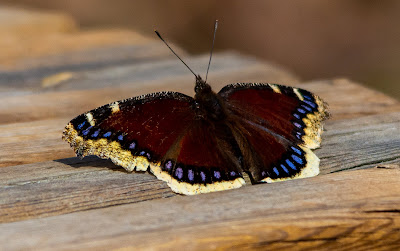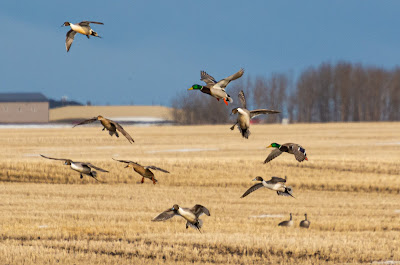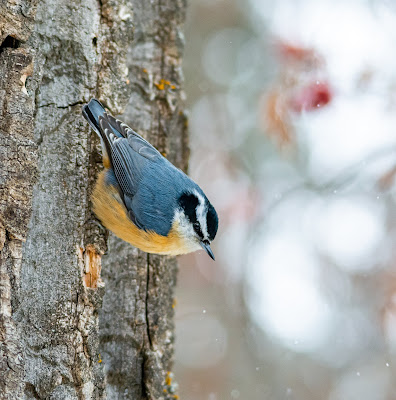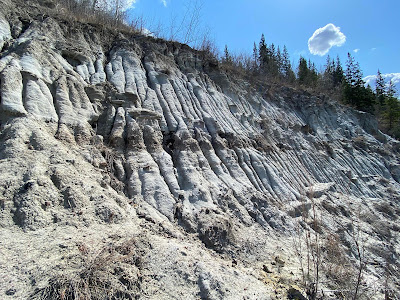Bugs for Birders: Learning to Love Invertebrates
Despite my diversity of interests, I have to admit to having a lifelong vertebrate bias. I've always been much more drawn to things like birds, mammals, reptiles, and their fossil kin than the all the creepy-crawlies buzzing and crawling around. In university I did take an invertebrate zoology course, but I took many more on vertebrates. I also have to admit to being more than a little squeamish around many bugs, worms, and other such animals. Shame, I know.
Some people might argue that it's natural to have a backbone-bias, since vertebrates tend to be A. more noticeable to the human eye given their size and B. more similar to us in their biology (even things like fish have much more in common with us than insects, arachnids, and so on). You also hear it argued that we're evolutionarily programmed to feel repulsed by most invertebrates which might sting, bite, or infect us, however this doesn't seem to stop many human cultures and indeed other primate species from making regular meals out of these animals. Plus the field of entomology, both professional and amateur, is neither new nor small. When you looks at the diversity of animal life on Earth with all its millions of animals species, arthropods (insects, crustaceans, arachnids, centipedes, etc.) make up about 75%. Mollusks come in second. Despite some people's disinterest or even repulsion to these animals, this is really the planet of the arthropods, and vertebrates like us are the weirdos who walk around with their hard parts on the inside.
Okay, so it's one thing to know all this, but how should everyday vertebrate-loving naturalists like us begin finding and noticing our native bugs? Well, I began to get into bugs after I started seriously bird watching. During summer walks through the woods with binoculars or camera in hand, sometimes I just couldn't get a good look at any interesting birds, no matter how hard I looked. However, there always seemed to be insects around. Dragonflies and damselflies zipping around wetlands, butterflies dancing from flower to flower, beetles crawling through the undergrowth or along plant stems... For too long I never took much notice of these animals, dismissing them as less interesting or impressive than the backboned animals I was looking for. After some time, though, I figured "well, if there's nothing else to take pictures of out here today, I'll entertain myself by photographing the bugs at least". This moved on to "well, I might as well try to identify the bugs in these photos", then to "hey, you can actually tell what many of these things are without a dichotomous key and decades of experience! And some of them are pretty cool!". It's all downhill into becoming a true bugster from there.
Nowadays when I'm out in nature, I pay about as much attention to the insects that catch my eye as I do birds, mammals, or amphibians. I'm far from being anywhere near an authority on them (there's still so many to learn!) but hey, you have to start somewhere.
With that said, here's an outline of some fairly easy insects for bird people to become familiar with. It's far from exhaustive, and while I tried to do as much research as possible to make it accurate, there's bound to be errors, so please comment if you have corrections or neat facts to add. Most of my info comes from Bugs of Alberta by John Acorn and Insects of Alberta, plus some of my own observations in the field, personal communication from experts when possible, and good old Wikipedia for the rest. All photos are by me, identifications are provided as specifically and confidently as reasonable.
Butterflies
For vertebrate people, especially bird people, I'd wager the easiest insects to get into are the order Lepidoptera, the butterflies. Many Albertan butterflies are big enough to see from a fair distance, and with their colourful wings and relatively slow flight they're both beautiful and fairly conspicuous. The nice thing about butterflies as well is, in Alberta at least, there aren't so many of them that learning the common species is a hassle. There's a few major butterfly families native to this province that can be distinguished pretty easily, then it's just a matter of getting to know each species.
Some of the easiest Alberta butterflies to find, as well as some of the most beautiful, are members of the Nymphalidae, also called the brush-foots. They might just be my favourite insects. These medium-sized butterflies have lovely colour patters on top side of their wings. However, in many species the underside of the wings are a dull brownish colour, allowing them to blend in with the vegetation when resting. This makes them tricky to see until they take flight, when they become little bursts of colours flittering through the woods. Nymphalids include many familiar species that any butterfly fan should know. There's the Nymphalini tribe, also known as the anglewings, which includes Milbert's Tortoiseshell (Aglais milberti), Mourning Cloak (Nymphalis antiopa), Painted Lady (Vanessa cardui), and the different types of commas (Polygonia). There's the admirals which include the White Admiral (Limenitis arthemis) and the famous monarch-mimicking Viceroy (Limenitis archippus), as well as the vibrant orange-and-black fritillaries (the Boloria and Speyeria genera make up our native species) and tiny crescents (Phyciodes), and the somewhat similar Monarch (Danaus plexippus). Last of the brush-foot butterflies are the Satyrinae, which includes the satyrs, browns, wood nymphs, and ringlets- small brownish butterflies of woodland and grassland areas.
 |
| Mourning Cloak (Nymphalis antiopa) |
 |
| Comma (Polygonia sp.) |
 |
| Fritillary (Speyeria)? |
 |
| Northern Crescent (Phyciodes cocyta) |
 |
| Milbert's Tortoiseshell (Aglais milberti) |
 |
| White Admiral (Limenitis arthemis) |
Then there are the gossamer-winged butterflies in the family Lycaenidae. This includes the blues (Polyommatinae) which have, obviously, vibrant metallic blue colouration on the upper sides of their wings, which are often rimmed with black and white patterns. There are several different genera of blues, The wing undersides are a pale gray with black spots. There's also the rusty-blue coppers (Lycaeninae) and the more subdued, brownish hairstreaks and elfins (Theclinae).
 |
| Western Tailed Blue (Everes amyntula) |
The whites and sulphurs (family Pieridae) are easy enough to recognize to the family level at a good distance, as Albertan species tend to be fairly plain with mostly white or yellow wings (aside from the marbles with their, well, marbled green and white wings). Common species in Alberta include the Clouded Sulphur (Colias philodice), the Mustard White (Pieris oleracea) and the introduced Cabbage White from Europe (Pieris rapae), which gets it name from the larval form's taste for domestic crops.
 |
| Clouded Sulphur (Colias philodice) |
There's also the small yet energetic skippers in the family Hesperiidae. These little butterflies have big eyes, stubby antennae, stumpy bodies, and relatively small wings, giving them a pretty cute look. They come in all different colours and habitat preferences, too. Some skipper species prefer forest meadows, some favour dry open grasslands, and others live in the mountains. Some, like the Persius Duskywing (Erynnis persius) are fairly drab, while others like the Arctic Skipper (Carterocephalus palaemon) have colourful spotted patterns.
 |
| Arctic Skipper (Carterocephalus palaemon) |
 |
| Common Roadside Skipper (Amblyscirtes vialis) |
Last of the butterflies we'll cover are Papilio, the swallowtails. Probably our most common and easy to see species would be the Canadian Tiger Swallowtail (Papilio canadensis). These butterflies are big and beautiful, with lovely yellow and black wings sporting blue and orange highlights making them hard to mistake for any other type of butterfly. Look for them fluttering around near aspen woodlands with lots of dandelion meadows where, to the attentive eye, they're hard to miss.
 |
| Canadian Tiger Swallowtail (Papilio canadensis) |
There are also moths, the fuzzy, often nocturnal cousins of the butterfly. Well, sort of. The term 'moth' is really just what we call all other lepidoterans that aren't in the butterfly group, the Rhopalocera. That means that some moths are more closely related to butterflies than they are to other moths. It also means that there are many, many different species of moths out there. Some are big and colourful, like the Polyphemus Moth (Antheraea polyphemus), while many others are more small and cryptic. I can't say I know moths nearly as well as I know butterflies (and even that isn't saying much) so we'll sadly have to skip them, but keep an eye out for moths all the same, because they're worth getting to know. I sure will. Before we move on, you might wonder how to tell if an insect is a butterfly or a moth, but all you need to do is look at the antennae- butterfly antennae tend to be skinny with those little round nubs on the ends, while in moths they lack the little round tips and are often fuzzy. Moths tend to be more nocturnal than butterflies, or you might think of butterflies as just diurnal moths, but as always in biology, there are exceptions.
 |
| Alfalfa Looper (Autographa californica) |
Dragonflies & Damselflies
The next most noticeable bugs to most birders would probably be dragonflies and damselflies, the Odonata. These insects spend their time in good birding spots, namely around wetlands and riversides in both forested and grassland areas. Of the two groups, dragonflies are probably the more noticable. After transforming from their aquatic larval stage, these brightly-coloured aerial hunters dart around with amazingly precise flight control, hunting smaller insects on the wing. With their long abdomens, elongate wings, and goggle-like eyes, they're unmistakable little fighter pilots.
The dragonfly family known as skimmers, or Libellulidae, is an easy group to encounter around ponds and wooded marshes. These tend to be brightly coloured in reds and yellows and have relatively short abdomens (for a dragonfly). One common genus I often see is the whiteface (Leucorhinna), which emerge relatively early in the year (late May). Young individuals have yellow markings that turn to red in the male as they age. The face is pale white. Other common skimmers include the Four-spotted Skimmer (Libellula quadrimaculata) and the Variegated Meadowhawk (Sympetrum corruptum).
 |
| Whiteface (Leucorhinna sp.) |
 |
| Four-spotted Skimmer (Libellula quadrimaculata) |
Another common dragonfly family are the Aeshnidae, or darners. Most Albertan species belong to the Aesha genus, the mosaic darners, and are found in different areas of the province. These large dragonflies tend to have greenish-blue markings and a long, narrow abdomen which is pinched-in near the base.
 |
| Darner (Aesha sp.) |
Once you know how to tell damselflies from dragonflies, it's easy to recognize them. Alberta damselflies tend to be fairly small, with long, extra skinny bodies and large round eyes on either side of the head. One common group of damselflies are the bluets, in the genus Enallagma. These little neon-blue insects dash around near wetlands across Alberta. They tend to look pretty similar too, and while identifying them in the field is possible, it takes some practice. There's also the spreadwing damselflies, genus Lestes. Unlike other damselflies, these ones tend to hold their wings slightly outspread when perched, unlike the bluets that fold their wings along their body when resting. Some, like the Spotted Spreadwing (Lestes congener) emerge relatively late in the season and can last as adults into early fall.
 |
| Bluet (Enallagma) |
 |
| Spotted Spreadwing (Lestes congener) |
Pond Bugs
When out at an Alberta wetland looking for waterfowl and such, peer down into the muddy water and you might see some invertebrates swimming around. Bring a net and bucket with you next time and you're sure to find an entire, diverse ecosystem of insects, crustaceans, and more in our prairie sloughs and forest ponds. Many insects that live in shallow fresh water do so only during their larval stages. This includes the nymphs, as their called, of the dragonflies and damselflies we just went over. Both are predators of other freshwater invertebrates, with alien-like extendable lower jaws for nabbing prey. Dragonfly larvae are also renowned for their jet-propulsion swimming by shooting water out their backsides. Damselfly larvae, on the other hand, are poor swimmers that lie in wait for prey.
Another group of ferocious pond predators are the predaceous diving beetles (Dytiscidae) and their equally fearsome larva known as water tigers. The larval form has an impressive set of jaws on its big, flat head. Unlike dragonflies and damselflies, when these beetles reaches adult hood it still spends much of its time under water, hunting just about anything it can grab. Diving beetles (there are many different genera and species) aren't exclusively aquatic, though, and will take wing and fly between different ponds. They'll even mistake shiny metal objects for water- I once took a country drive in the spring looking for bluebirds and found dozens of them sitting on the roof of my blue car. Another beetle predator that is a bit cuter and swims in an amusingly erratic way are the little black whirligig beetles (Gyrinus). Watch for them darting around on the water's surface.
 |
| Water tiger (Dytiscidae) |
There's caddisflies (Trichoptera) and mayflies (Ephemeroptera), two flying insects that also have aquatic larvae. Caddisfly larvae are known for their neat habit of making special 'cases' for themselves out of bits and pieces of stuff they find at the bottom of the pond. This is to protect these small scavengers from the aforementioned predators. Mayfly larvae are also pretty defenseless, but they manage to get by without the body armor. Mayflies are renowned for their day-long adult lifespan, which is spent breeding, laying eggs, and dying. Since they spend much more time as larvae that actually feed and interact more with the world, I like to think of this stage as the 'main' form of the mayfly, if understand me.
Then there are the water bugs. And by that I mean true bugs. We often casually refer to insects and other small invertebrates as 'bugs', but to be strictly scientific the only 'true bugs' are those of the insect order Hemiptera, all of which have a unique set of modified mouthparts that form a sort of extendible 'beak' for sucking up food. Some are cute little paddlers like the water boatmen (Corixidae) or backswimmers (Notonectidae) that zip through the water harmless to us. Others, like the Giant Water Bug (Lethocerus americanus) are big and scary, with painful bites. This impressive bug will even fly around at night and become drawn like a moth to lamps- something to keep in mind when you're standing under the porch light on a summer evening.
 |
| Water Boatman (Corixidae) |
Garden Bugs
Both cultivated gardens and natural ones like flowery meadows are good places for birders, what with nectar-feeding hummingbirds and many more species that eat insects and seeds. If you spend some time among the flowers you'll certainly notice lots of bugs as well. The closer you pay attention, the more species you'll notice.
 |
| Bumblebee (Bombus sp.) |
We already covered butterflies, but many other types of insects are drawn to flowers and leaves for different reasons. Some, like our native bumblebees (Bombus) are are easy to spot as they fumble their way towards the center of the flower, clinging on like little winged pandas as they feed. But did you know a whole variety of other insects and other arthropods hang out in and around flowers? Many non-bug people might think of beetles as little metallic things that crawl across the forest floor, but a whole assortment of beetles live and forage on different plant parts. A close look at the center of a flower might give you a glimpse of a lepturine beetle. There are many different species in this subfamily, lots of which have impressive colours and long antennae. Native wild roses are nice and large as far as Albertan flowers go- great to peer into and check for beetles hanging out. Ladybugs (Coccinellidae) hunt for smaller insects like aphids on stems and leaves on different plant species too.
 |
| Grammoptera subargentata (?) |
 |
| Evodinus monticola (?) |
Look hard enough and you might also spot the ghostly Goldenrod Crab Spider (Misumena vatia). This pale hunter sets itself up inside a flower and, once an insect comes in looking for nectar, the spider strikes and grabs its hapless prey. In brightly-coloured flowers this small spider can stand out if you pay enough attention to look for it, at least to human eyes, but in pale flowers it can be more difficult to spot. You can understand how some oblivious butterfly might accidentally perch right in front of one, leading it its demise.
 |
| Goldenrod Crab Spider (Misumena vatia) |
The End, and the Beginning
Well budding bugsters, hopefully this has partially opened some eyes to the massive world of insects and other invertebrates. This is less than the tip of the giant entomology iceberg, though. Learning about insects is a lifetime pursuit, and you can understand why many folks specialize in one particular group. There are good resources out there that can help you become better acquainted with the bugs in your area, but given their overwhelming diversity, there really isn't any one single volume that acts as a comprehensive field guide to all of Alberta's invertebrate life. Adding to the difficulty is that many insects and other invertebrates don't have common names and some take a lot of expertise to identify.
To any bug experts who may read this, I can only ask forgiveness for the errors in facts or misidentifications that I'm sure made their way into this post, and for the audacity to even try. I can only plead that I'm a helpless vertebrate fan (vertebrophile?) trying to learn by teaching others. More folks trying keep a dialogue about Alberta's native bugs in as much of an educated manner as possible can only be a good thing, right?
If you really want to get into bugs as part of your nature hobbies, there are great communities, clubs, and societies of knowledgeable insect enthusiasts around the province, plus social media groups and other such things. Renowned experts at the Royal Alberta Museum and University of Alberta curate world-class entomology collections, and the museum's 'Bug Room' has been popular place to learn about these animals for decades.
And that brings me to my last point. Even though insects, arachnids, crustaceans, and all those other creepy-crawlies might look to alien to many of us, they too are nothing more or less than animals. They've been citizens of this planet much longer than we have, and whether we know it or not they're always there in the background pollinating the plants we rely on, devouring the waste we leave behind, and acting as a vital part of every food web on the planet. Something to think about next time you reach for the fly swatter.
 |
| http://scienceborealis.ca. |




Comments
Post a Comment